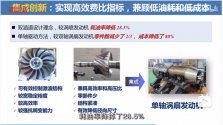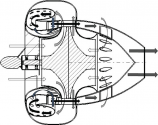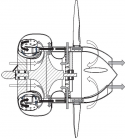It is scramjet.
Ramjet control tech wins top prize!
You are using an out of date browser. It may not display this or other websites correctly.
You should upgrade or use an alternative browser.
You should upgrade or use an alternative browser.
Chinese Engine Development
- Thread starter jackbh
- Start date
Have this been shared before? The lecture/presentation took place in on July 29. The video was uploaded on Oct 8.
The presenter is a fellow of the institute of engineering thermophysics (IET) of CAS.
According to the presentation, IET have developed three new series of light gas turbines for UAV -
1. Super-sonic turbojet engines with all electric controls including fuel and oil pumps, and the variable engine nozzle.
2. Turbofan engines for high service ceiling (up to 20km) and low fuel consumption. 3 models of different power output, 750kg, 1000kg and 400kg, have been put in UAVs and entered service.
3. "High performance/price ratio, single-axis" turbofan engines, a first in the world, less fuel consumption than turbojet at low cost.
Because of these achievements, IET has become a "national key lab of science and technology on advanced light duty gas-turbine". They have started building China's first "big science facility" in aerial engines: "air-breathing engine key parts thermophysics test bed". The test bed will be able to simulate flight conditions in altitude between 0-30 km and in speed between 0-6 mach.
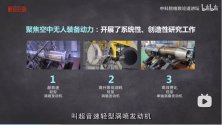

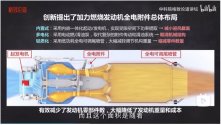

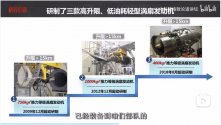

The presenter is a fellow of the institute of engineering thermophysics (IET) of CAS.
According to the presentation, IET have developed three new series of light gas turbines for UAV -
1. Super-sonic turbojet engines with all electric controls including fuel and oil pumps, and the variable engine nozzle.
2. Turbofan engines for high service ceiling (up to 20km) and low fuel consumption. 3 models of different power output, 750kg, 1000kg and 400kg, have been put in UAVs and entered service.
3. "High performance/price ratio, single-axis" turbofan engines, a first in the world, less fuel consumption than turbojet at low cost.
Because of these achievements, IET has become a "national key lab of science and technology on advanced light duty gas-turbine". They have started building China's first "big science facility" in aerial engines: "air-breathing engine key parts thermophysics test bed". The test bed will be able to simulate flight conditions in altitude between 0-30 km and in speed between 0-6 mach.






by78
General
Have this been shared before? The lecture/presentation took place in on July 29. The video was uploaded on Oct 8.
The presenter is a fellow of the institute of engineering thermophysics (IET) of CAS.
According to the presentation, IET have developed three new series of light gas turbines for UAV -
1. Super-sonic turbojet engines with all electric controls including fuel and oil pumps, and the variable engine nozzle.
2. Turbofan engines for high service ceiling (up to 20km) and low fuel consumption. 3 models of different power output, 750kg, 1000kg and 400kg, have been put in UAVs and entered service.
3. "High performance/price ratio, single-axis" turbofan engines, a first in the world, less fuel consumption than turbojet at low cost.
Because of these achievements, IET has become a "national key lab of science and technology on advanced light duty gas-turbine". They have started building China's first "big science facility" in aerial engines: "air-breathing engine key parts thermophysics test bed". The test bed will be able to simulate flight conditions in altitude between 0-30 km and in speed between 0-6 mach.
Nice lecture. Here's the same video on Youtube in HD for those who don't want to sign up for Bilibili to get the HD quality.
A high-resolution capture of the slide on the three engines:

The supersonic turbojet on the testbench:
We do know that a Y-20 has been used by the AECC as a propulsion test platform for the CJ-1000A engine, which is first spotted sometime in January this year.
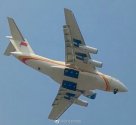
In that case, do we know which plane in China can become the most suitable propulsion test platform for the CJ-2000? The Y-20 doesn't seem to be big enough to hold one CJ-2000 on the inner pylon of one of its wings without interfering with the WS-18 engine on outer pylon of the same wing.

In that case, do we know which plane in China can become the most suitable propulsion test platform for the CJ-2000? The Y-20 doesn't seem to be big enough to hold one CJ-2000 on the inner pylon of one of its wings without interfering with the WS-18 engine on outer pylon of the same wing.
Last edited:
We do know that a Y-20 has been used by the AECC as a propulsion test platform for the CJ-1000A engine, which is first spotted sometime in March this year.
View attachment 120905
In that case, do we know which plane in China can become the most suitable propulsion test platform for the CJ-2000? The Y-20 doesn't seem to be big enough to hold one CJ-2000 on the inner pylon of one of its wings without interfering with the WS-18 engine on outer pylon of the same wing.
In terms of dimensions, I don't see why the Y-20 would be an issue.
Il-76 has tested NK-93 with a 2.9 meter diameter not to mention the D-27 turboprop with an overall diameter of over 4 meters.
CJ-2000 will probably have a diameter of 3 meters or under, so it shouldn't be an issue for Y-20 to accommodate next to D-30 engines.
by78
General
The AGT-7 gas turbine is a 7MW-class gas turbine derived from WS-10 Taihang. Suitable for marine propulsion. Civilian applications include power generation for offshore oil and gas platforms, backup power generation, etc.
Some specs:
– Power: 6850kW
– Generator efficiency: 32.1%
– Exhaust flow rate: 27.6kg/s
– Exhaust temperature: 560°C
– Output rotational speed: 8300rpm

Not sure if this has been shared before, but the first batch of two AGT-7B turbine generators . They were installed on a CNOOC offshore oil platform.

yes. this is a major breakthrough. CCTV aired complete documentary on this.Not sure if this has been shared before, but the first batch of two AGT-7B turbine generators . They were installed on a CNOOC offshore oil platform.

It is China's first indigenous gas turbine that has been put into operation on the sea.

Lufeng 8-1 platform is now 100 percent indigenous.
some key points -
Now we have connected the Lufeng 8-1 platform to the grid of the whole oil field," said Yue Zongling, director of the platform. "This platform has become the core of the grid."
The engineers behind the Taihang-7 introduced new concepts to the design of the machine, enabling it to run on both diesel and gas. The gas turbine is the world's first of its kind to have dual-fuel capabilities.
"It is about 15 percent cheaper than imported generators," said Gao Shuang, deputy manager of the Deepwater Engineering Center at the Shenzhen branch of the China National Offshore Oil Corporation. "The maintenance cost will also be greatly reduced."
One of the designers told China Media Group that they invented hundreds of new technologies, processes, standards and materials during the making of the Taihang-7.
The country has established the whole industry chain of building such turbines.
"We have been designing gas turbines with our own intellectual properties," said Zhao Yong, chief designer of the gas turbine.
Love the hammer-and-sickle flag in the back.Not sure if this has been shared before, but the first batch of two AGT-7B turbine generators . They were installed on a CNOOC offshore oil platform.



